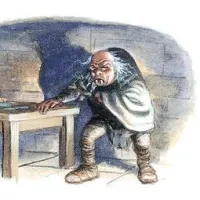Australia is famous for its huge swathes of untouched wilderness and for the unique, often deadly animals that wander there. You wouldn’t expect that a nation with the likes of the platypus and the killer box jellyfish would need to invent a new creature to add to its allure, yet reports of a mysterious, massive creature lurking in the waters of Australia abound. This creature, the Bunyip, is as much a part of Australian culture as any of its other fantastic beasts. The Bunyip (translated in Aboriginal Australian to mean devil or evil spirit), also known as the Kianpraty, is a creature of Aboriginal mythology. It lives in swamps, billabongs, creeks, riverbeds and waterholes all over Australia. The Bunyip has many descriptions. Some say it has a dog-like face, dark fur, a horse-like tail, flippers, walrus-like tusks, and a duck-like bill. Others think the creature has an appearance similar to a snake with a man and a beard. Some even think that the Bunyip is actually the prehistoric marsupial, Diprotodon australis, that managed to escape extinction. But the figure of the Bunyip was part of traditional Aboriginal beliefs and stories throughout Australia, while its name varied according to tribal nomenclature. In his 2001 book, writer Robert Holden identified at least nine regional variations of the creature known as the Bunyip across Aboriginal Australia. Europeans recorded various written accounts of Bunyips in the early and mid-19th century, as they began to settle across the country.
When Europeans first arrived in New Holland (as Australia was originally named), they were the latecomers. Indigenous Australians arrived in Australia 40,000 years earlier and it is suggested that Indigenous Australians have the longest continual cultural history of any people on the planet. The cultural history of Indigenous Australians is integrally connected with the Australia landscape and customs, wisdom and tribal laws are passed down the generations through story telling. Indigenous Australians are a diverse group of peoples with their own languages, legends and norms based around the tribe’s territory (known as ‘country’) and this means the Bunyip tales vary from tribe to tribe. The British formally settled Australia at Botany Bay in 1788 and as the British and the Indigenous people made contact, the stories of the Bunyip were passed from one culture to another. Coming from Britain, the new world of Australia was an alien landscape for the colonists, a land filled with weird and exotic animals. Over half of the First Fleet were convicts, with little experience of the world outside English cities and towns. Imagine their first reactions to seeing a kangaroo, an echidna or a platypus? No wonder the tales of the Bunyip were accepted by the settlers. The Bunyip was obviously another unusual animal in this strange new land, although a little harder to catch.
No one knows exactly what The Bunyip looks like — but they know to stay away. Facts about the Bunyip are a little harder to come by – what is known is largely fragmentary and of dubious origin. For instance, it is said that the Bunyip lurks in swamps, billabongs, creeks, riverbeds, and waterholes. The most frequent reports of Bunyip sightings came from the southeastern colonies of Victoria, New South Wales, and South Australia in the 1840s and 1850s. In these reports, the Bunyip is an aquatic mammal. It has smooth skin, ‘apricot’ eyes, and a bellowing cry that it releases before pouncing on its victims and devouring them. Aborigines have differing opinions on the Bunyip. Some believe it is a bloodthirsty murderer, but others have called the Bunyip a punisher sent to Earth to bring justice to anyone who commits evil acts and to protect the wildlife. In 1851, a newspaper called The Australasian published a report about a Bunyip being speared after killing an Aboriginal man. The creature was eleven paces long and four paces in width. Aboriginal people used to visit the sight of the creature every year and outline its form, but those outlines have been lost over time. Witnesses have trouble describing the appearance of The Bunyip. The most popular description is that it looks like an enormous starfish. However, some people claim it looks like a snake with a beard. Others argue it has a dog-like face, a crocodile-like head, dark fur, a horse-like tail, flippers, walrus-like tusks, and a duck-like bill. The Bunyip darkened the folklore of Australia’s Aboriginal people for centuries before it made its debut in the written records of European settlers, who bought into the legend wholeheartedly. Originally, the monster went by a different name in each indigenous tribe: the Wowee-wowee, the Yaa-loo, the Kianpraty, the Dongu, and more. When Europeans got their hands on these various monsters, they united them under the single most popular name: Bunyip.
The earliest documented evidence of the Bunyip is a set of huge, mysterious bones found by the famous explorer Hamilton Humes in 1818. Humes didn’t name these bones as the Bunyip, instead believing that they might have come from a manatee or hippopotamus. However, the scholars who heard about his discovery couldn’t help but think of the monster described by Aborigine people, and the Philosophical Society of Australasia offered to pay Humes to return the lake where he had found the skeleton and transport it to their headquarters. Humes declined. In 1830, another set of bones were unearthed in Wellington Cave. The anatomist Sir Richard Owen identified these bones as belonging to a giant, extinct marsupial species, at the same time noting that the surrounding tribes had a tradition about a similar giant creature living in nearby waterways. In 1845, the Geelong Advertister announced yet another fossil discovery, this time claiming that the fossil had been identified by an Aborigine man as belonging to a previously unknown species: the Bunyip. This story kickstarted a firestorm of monster sightings across Australia. In 1847, a bizarre skull was found and attributed to the now extremely popular monster. Although experts identified the skull as belonging to a deformed fetal calf, it was accepted into the Australian Museum in Sydney, where it was displayed as evidence of the Bunyip. The display was wildly popular, until the skull was mysteriously stolen from the museum. Another slurry of sightings followed in the wake of the museum’s display, but by the end of the 1850s, the monster’s fame had entered a slump.
Today, the Bunyip is largely regarded as no more than a charming bit of folklore. He is usually portrayed as a gentle giant, and he has even starred in children’s books and television series. The Australian tourism boom of the 1970s brought a renewed interest in Bunyip mythology – in 1972, for example, a coin-operated bunyip was built by Dennis Newell at Murray Bridge, South Australia, at Sturt Reserve on the town’s riverfront. In 1996 Australian children’s author Jackie French wrote several Bunyip tales, including the short story Bunyip’s Gift, collected in the anthology Mind’s Eye. An Australian horror movie titled Bunyip is about a group of city folk who decide to hike in the Australian wilderness but end up getting lost and have to survive against the legendary creature. Another Australian horror movie titled Red Billabong pits two brothers who uncover their family’s secrets and realise that their friends go missing but don’t realise that the legendary Bunyip is to blame and now is stalking them. Bunyips even recently appeared as the focus cryptids in an episode of The Secret Saturdays; however, they were depicted as small, troublemaking creatures instead of monsters. Interestingly, the monster’s name has also picked up some political connotation. It can be used as a derogatory term to belittle political movements that are made up of “imposters” or “humbug.” During the 1850s, it was used to mock “the bunyip aristocracy,” a group of European settlers who aspired to create a new class in Australian society. In the 1930s, the word was used again as an attack on the Liberal Party of Australia. Whether real or imagined, the myth of the Bunyip is nothing if not flexible – as well as surprisingly resilient.

















Reblogged this on Hugh Paxton's Blog.